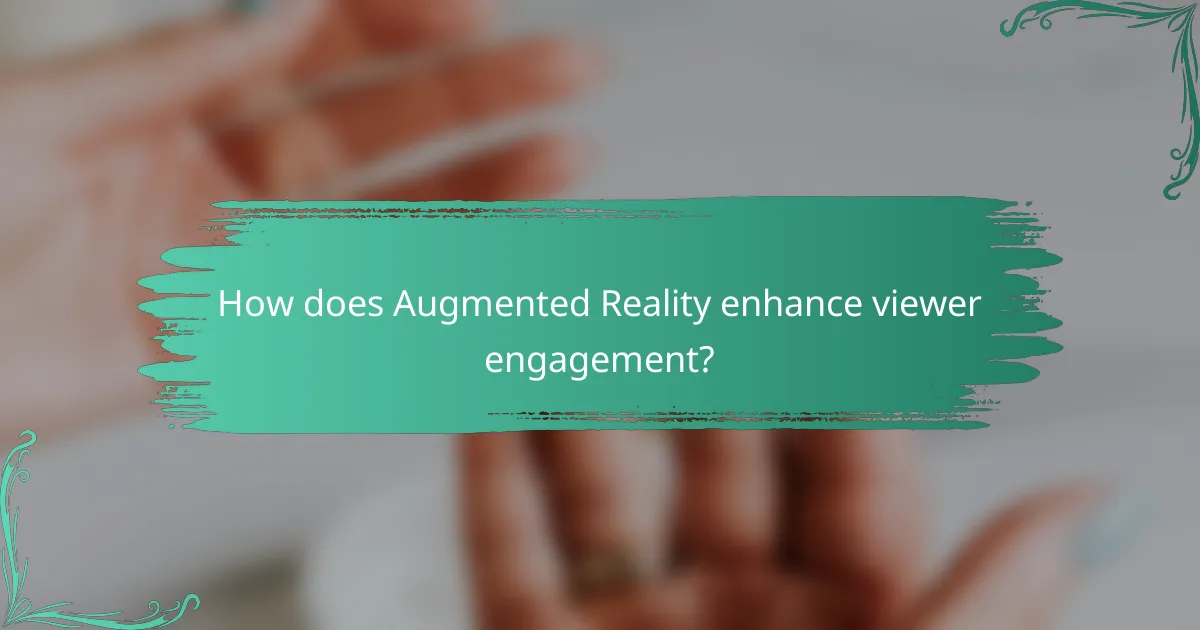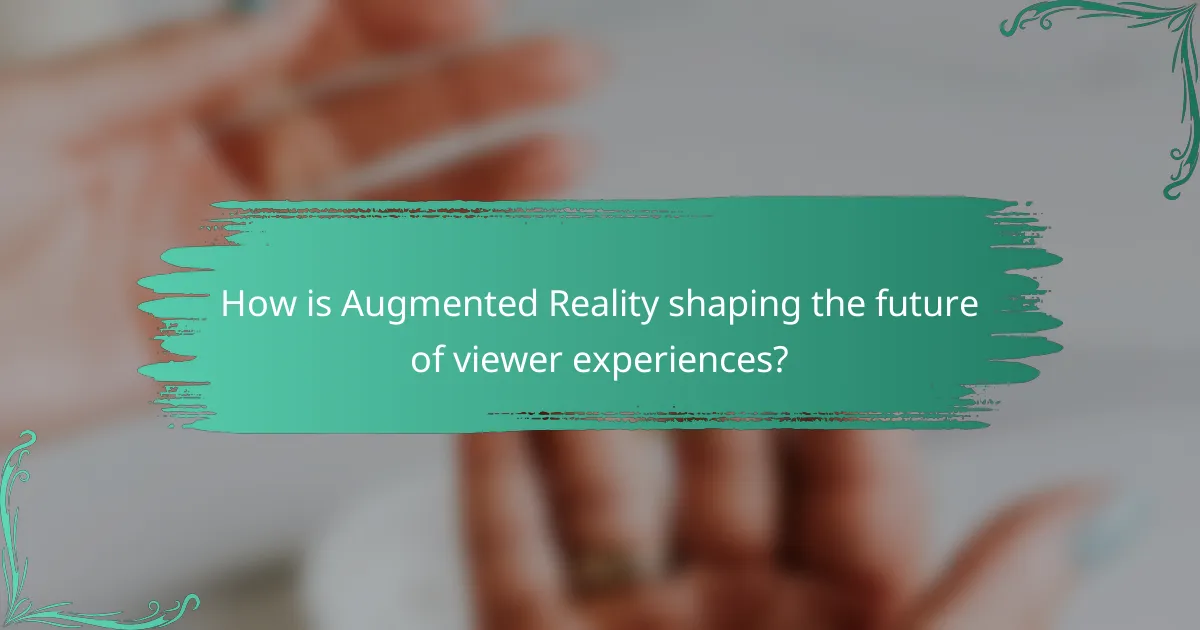Augmented Reality (AR) transforms viewer experiences by merging digital content with the physical world, fostering interactivity and engagement. This technology not only captivates users but also encourages active participation, making it a powerful tool for businesses to enhance customer interactions and promote brand loyalty through memorable experiences.

How does Augmented Reality enhance viewer engagement?
Augmented Reality (AR) significantly enhances viewer engagement by creating interactive and immersive experiences that captivate users. By blending digital content with the real world, AR encourages active participation and deeper connections with the material presented.
Increased interactivity through immersive experiences
AR fosters increased interactivity by allowing users to engage with digital elements in their physical environment. For instance, users can manipulate 3D models or interact with virtual characters, making the experience more dynamic and personalized. This level of engagement can lead to longer viewing times and a more memorable experience.
Applications in education, such as AR-enhanced textbooks, allow students to visualize complex concepts through interactive diagrams and simulations. This hands-on approach can enhance understanding and retention of information.
Real-time feedback and user participation
Real-time feedback is a crucial aspect of AR that enhances viewer engagement. Users can receive immediate responses to their actions, which encourages exploration and experimentation. For example, in AR gaming, players can see the consequences of their decisions instantly, making the experience more engaging.
Moreover, user participation can be amplified through features like social sharing and collaborative tasks. This not only boosts engagement but also fosters a sense of community among users, as they can share their experiences and achievements with others.
Enhanced storytelling and brand narratives
AR enhances storytelling by integrating digital narratives into the viewer’s real-world context. Brands can create immersive stories that resonate with their audience, making the content more relatable and impactful. For example, a fashion retailer might use AR to allow customers to visualize how clothing would look on them before making a purchase.
Additionally, AR can transform traditional marketing strategies by providing interactive experiences that captivate consumers. Brands that effectively leverage AR storytelling can differentiate themselves in a crowded market, leading to increased brand loyalty and customer engagement.

What are the best Augmented Reality applications for marketing?
The best augmented reality applications for marketing enhance customer engagement and provide interactive experiences. These applications effectively showcase products, promote brands, and create memorable interactions that can lead to increased sales and brand loyalty.
IKEA Place for furniture visualization
IKEA Place allows customers to visualize how furniture will look in their homes using augmented reality. Users can place true-to-scale 3D models of IKEA products in their own spaces through their smartphones, making it easier to choose the right items.
This application not only helps in decision-making but also reduces the likelihood of returns, as customers can see how a piece fits with their existing decor. It is particularly effective in markets where online shopping is prevalent, as it bridges the gap between physical and digital shopping experiences.
Snapchat filters for brand promotion
Snapchat filters offer brands a unique way to engage users by allowing them to overlay branded graphics on their photos and videos. These filters can be customized for specific events or campaigns, encouraging users to share their experiences on social media.
Brands benefit from increased visibility and user-generated content, which can lead to organic reach. The key is to create filters that resonate with the target audience and encourage sharing, thus amplifying brand presence in a fun and interactive manner.
Pepsi Max’s bus shelter AR campaign
Pepsi Max’s bus shelter campaign used augmented reality to create an immersive experience for commuters. By transforming a standard bus shelter into a virtual environment, they showcased engaging scenarios, such as a giant robot or a tiger, surprising and delighting passersby.
This innovative approach not only captured attention but also generated significant buzz on social media. Brands looking to implement similar campaigns should focus on creating memorable experiences that encourage sharing and interaction, maximizing the impact of their marketing efforts.

How can businesses implement Augmented Reality in advertising?
Businesses can implement Augmented Reality (AR) in advertising by creating interactive experiences that engage customers and enhance product visibility. This can be achieved through AR applications, social media integrations, and immersive experiences at events.
Utilizing AR apps for product demonstrations
AR apps enable businesses to showcase their products in a virtual environment, allowing customers to visualize items in their own space. For example, furniture retailers can use AR to let customers see how a sofa would look in their living room before making a purchase.
When developing an AR app, consider user experience and ease of use. Ensure the app is compatible with common devices and provides clear instructions for users to maximize engagement.
Integrating AR with social media platforms
Integrating AR features into social media platforms can significantly enhance brand visibility and engagement. Brands can create AR filters or effects that users can interact with, encouraging them to share their experiences online.
For effective integration, focus on platforms popular with your target audience, such as Instagram or Snapchat. Monitor engagement metrics to refine your AR content and ensure it resonates with users.
Creating AR experiences for events and exhibitions
At events and exhibitions, AR can create memorable experiences that attract attendees and promote products. Businesses can set up AR installations that allow visitors to interact with products in innovative ways, such as virtual try-ons or interactive displays.
To maximize impact, plan your AR experience to align with the event’s theme and audience interests. Provide clear signage and staff assistance to guide attendees through the AR experience, ensuring they understand how to engage with the technology.

What are the key technologies behind Augmented Reality?
The key technologies behind Augmented Reality (AR) include computer vision, depth tracking, and AR software development kits (SDKs). These technologies work together to create immersive experiences by overlaying digital content onto the real world.
Computer vision for environment mapping
Computer vision is essential for AR as it enables devices to understand and interpret the physical environment. This technology uses cameras and sensors to detect surfaces, objects, and their spatial relationships, allowing digital elements to be accurately placed in the real world.
For instance, when using AR applications, the device analyzes the surroundings to create a 3D map. This mapping helps in recognizing flat surfaces like tables or floors, ensuring that virtual objects appear grounded and interact seamlessly with the physical space.
Depth tracking for spatial awareness
Depth tracking enhances spatial awareness by measuring the distance between the device and objects in the environment. This technology is crucial for ensuring that virtual elements maintain proper scale and perspective relative to real-world objects.
Devices often utilize various sensors, such as LiDAR or stereo cameras, to gather depth information. This allows AR applications to provide more realistic interactions, such as placing a virtual chair in a room that users can walk around and view from different angles.
AR SDKs like ARKit and ARCore
AR SDKs, such as ARKit for iOS and ARCore for Android, provide developers with the tools needed to create AR experiences. These frameworks simplify the integration of computer vision and depth tracking, enabling developers to focus on content creation rather than underlying technology.
Using these SDKs, developers can access features like motion tracking, environmental understanding, and light estimation. This allows for the development of applications that can run on a wide range of devices, enhancing accessibility and user engagement in AR experiences.

What are the challenges of using Augmented Reality in campaigns?
Using Augmented Reality (AR) in campaigns presents several challenges that can hinder its effectiveness. Key issues include high development costs, user accessibility, device compatibility, and privacy concerns regarding data collection.
High development costs for quality experiences
Creating high-quality AR experiences often requires significant investment in technology and talent. Development costs can range from thousands to millions of dollars, depending on the complexity of the project and the expertise needed.
Brands must weigh the potential return on investment against these costs. Focusing on simpler, well-defined AR applications can help manage expenses while still delivering engaging experiences.
User accessibility and device compatibility
Not all users have access to the latest devices capable of supporting advanced AR experiences. This limits the reach of AR campaigns, especially in regions where high-end smartphones are less common.
To maximize accessibility, brands should consider developing AR content that works on a wider range of devices, including older models. Providing clear instructions on how to access AR features can also enhance user engagement.
Privacy concerns with data collection
AR applications often require data collection to function effectively, which raises privacy concerns among users. Many individuals are wary of sharing personal information, making them hesitant to engage with AR content.
To address these concerns, brands should be transparent about data usage and ensure compliance with regulations such as GDPR. Implementing robust security measures and offering users control over their data can help build trust and encourage participation in AR campaigns.

How is Augmented Reality shaping the future of viewer experiences?
Augmented Reality (AR) is transforming viewer experiences by blending digital content with the real world, enhancing engagement and interactivity. This technology allows users to interact with virtual elements in their physical environment, creating immersive experiences that captivate audiences across various sectors.
Integration with virtual reality for hybrid experiences
The combination of Augmented Reality and Virtual Reality (VR) creates hybrid experiences that offer the best of both worlds. Users can switch between fully immersive VR environments and AR overlays, allowing for versatile applications in gaming, training, and education.
For instance, a training program might use VR to simulate a complex scenario while incorporating AR to provide real-time data overlays, enhancing the learning experience. This integration can lead to more effective training outcomes and higher engagement levels.
Advancements in AI for personalized AR
Artificial Intelligence (AI) is playing a crucial role in personalizing Augmented Reality experiences. By analyzing user behavior and preferences, AI can tailor AR content to individual needs, making interactions more relevant and engaging.
For example, retail apps can use AI to recommend products based on a user’s past purchases and preferences, displaying them in AR for a more interactive shopping experience. This personalization can significantly improve user satisfaction and increase conversion rates.
